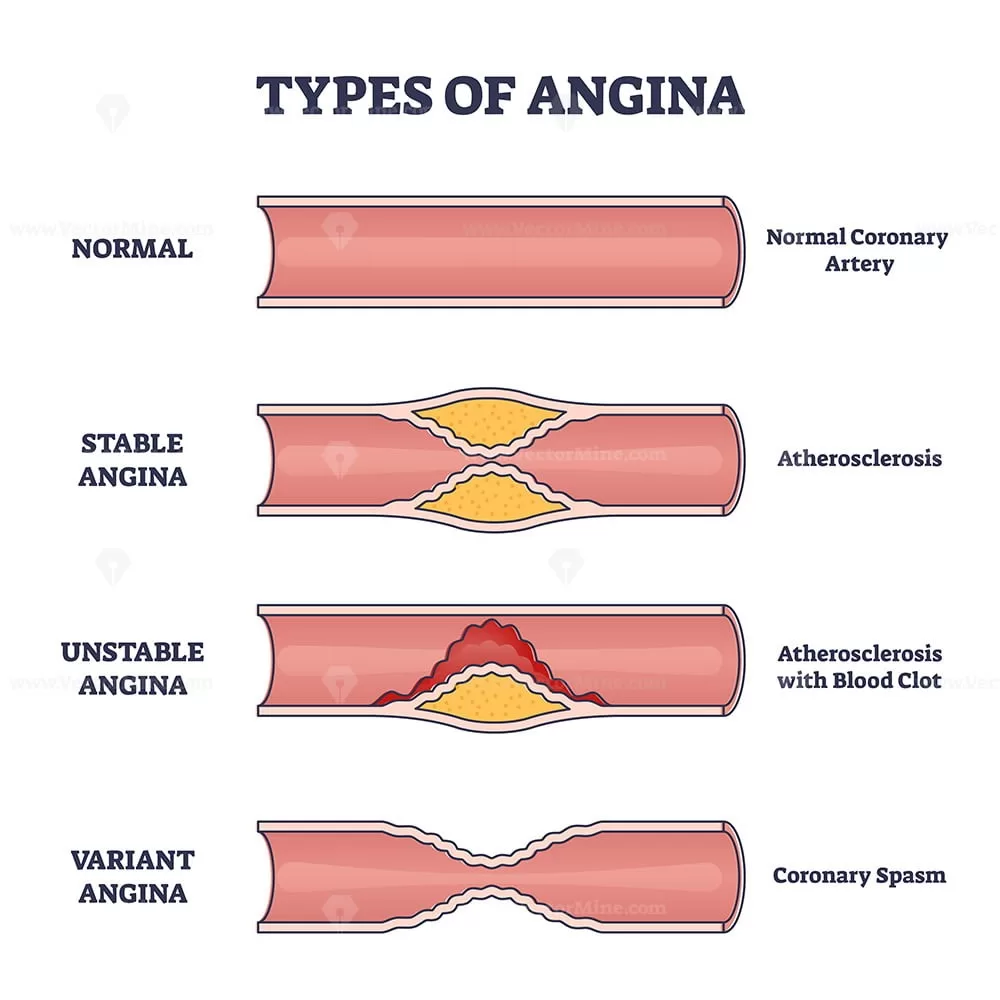Understanding angina is crucial for anyone concerned about cardiovascular health, as it refers to chest pain or discomfort resulting from reduced blood flow to the heart muscle. Often linked to coronary artery disease, angina symptoms can manifest as pressure or aching in the chest and may radiate to other areas such as the shoulders and arms. There are various types of angina, including stable and unstable forms, each presenting unique challenges in diagnosis and treatment. Effective angina treatments range from lifestyle modifications to medications designed to improve heart function and alleviate discomfort. By recognizing the signs and seeking appropriate care, individuals can significantly improve their quality of life and manage their cardiovascular disease risk.
Angina pectoris, commonly known as angina, describes a significant medical condition characterized by chest discomfort due to inadequate blood supply to the heart. This cardiovascular issue can present itself in different forms, such as stable or unstable angina, each with distinct symptoms and implications for treatment. Individuals might experience various sensations, from pressure in the chest to pain radiating to the arms or jaw, which are vital indicators of underlying heart health. Understanding these aspects is essential for proper management and timely intervention. Treatment strategies often include lifestyle changes and pharmacological therapies to enhance heart health and mitigate risks associated with cardiovascular disease.
Understanding Angina: Definition and Overview
Angina, or angina pectoris, is characterized by chest pain or discomfort that occurs when the heart muscle does not receive enough oxygen-rich blood. This condition is often a symptom of underlying cardiovascular issues, primarily due to coronary artery disease (CAD). Angina serves as a warning sign that should not be ignored, as it can indicate significantly reduced blood flow to the heart, potentially leading to more serious conditions like heart attacks. Recognizing the nature of angina, including its causes and triggers, is essential for effective management.
The sensation of angina can vary from person to person. Patients commonly describe it as a feeling of pressure, squeezing, or a heavy weight on the chest. This discomfort can radiate to other parts of the body, such as the arms, back, neck, or jaw. Understanding angina is crucial for those at risk of cardiovascular diseases, as early recognition of symptoms can lead to timely medical intervention and better health outcomes.
Types of Angina: Recognizing Variations
There are several types of angina that individuals may experience, each with distinct characteristics and implications. Stable angina is the most common, typically occurring during physical exertion or emotional stress, and often subsiding with rest or medication. It is essential for patients to learn how to recognize this type of angina, as it can be managed effectively with lifestyle changes and medication.
On the other hand, unstable angina presents a more serious concern. This type can occur unexpectedly, even at rest, and may signal an impending heart attack. It is crucial for individuals to understand the differences between stable and unstable angina, as the latter requires immediate medical attention. Additionally, microvascular angina, which affects small blood vessels rather than the larger coronary arteries, is particularly prevalent among women and can present atypical symptoms such as fatigue and anxiety.
Symptoms of Angina: Key Indicators to Watch For
Recognizing the symptoms of angina is vital for timely intervention and management of heart health. Common symptoms include chest pain or discomfort, shortness of breath, fatigue during physical exertion, and heart palpitations. However, it is important to note that symptoms can vary significantly between individuals, and some may experience more subtle signs, particularly women who may present with symptoms like mental fatigue or anxiety rather than classic chest pain.
Understanding these symptoms can empower individuals to seek medical help when necessary. Awareness of the signs of angina can lead to earlier diagnosis and treatment, reducing the risk of progression to more severe cardiovascular conditions. Patients should discuss any concerns regarding angina symptoms with their healthcare providers to develop a comprehensive care plan tailored to their specific needs.
Recent Insights into Angina Treatments
Recent research has focused on improving the management of angina through both lifestyle changes and advanced medication options. Self-care strategies, such as dietary modifications and stress management techniques, have been emphasized as effective ways to alleviate symptoms and improve quality of life for individuals with angina. Incorporating heart-healthy foods and engaging in regular physical activity can significantly impact overall heart health.
Additionally, ongoing studies are exploring the efficacy of various medications for treating angina, such as calcium antagonists, which have shown promise in managing symptoms and associated hypertension. Understanding the latest insights and treatment options for angina can empower patients to take active roles in their health care, ensuring they receive the most effective therapies available.
Comprehensive Angina Treatment Options
The treatment of angina typically involves a combination of lifestyle modifications, medications, and, in some cases, surgical interventions. Lifestyle changes play a crucial role in managing angina symptoms, with a focus on adopting a heart-healthy diet that prioritizes fruits, vegetables, whole grains, and lean proteins. Regular exercise tailored to individual capabilities can also enhance cardiovascular health and reduce the frequency of angina episodes.
In addition to lifestyle changes, healthcare providers may prescribe various medications to help manage angina. Common options include beta-blockers, nitrates, and calcium channel blockers, each designed to improve blood flow to the heart and alleviate symptoms. For patients with more severe cases, surgical options like angioplasty or coronary artery bypass grafting (CABG) may be considered to restore proper blood flow. Understanding these treatment options is vital for individuals diagnosed with angina to ensure they receive comprehensive and effective care.
Frequently Asked Questions
What are the common symptoms of angina?
Understanding angina symptoms is crucial for early intervention. Common symptoms include chest pain or discomfort, shortness of breath, fatigue during physical exertion, and heart palpitations. Some individuals, especially women, may experience less typical signs such as mental fatigue and anxiety rather than classic chest pain.
What types of angina exist and how do they differ?
There are three primary types of angina: stable angina, which occurs predictably during exertion; unstable angina, which is unpredictable and can happen at rest, indicating a potential heart attack; and microvascular angina, which affects individuals with normal coronary arteries but involves narrowed microvessels, often presenting with fatigue and anxiety.
What treatments are available for managing angina?
Angina treatments encompass lifestyle modifications such as a heart-healthy diet and regular exercise, along with medications like beta-blockers, nitrates, and calcium channel blockers. In severe cases, surgical options such as angioplasty or coronary artery bypass grafting (CABG) may be considered to improve blood flow to the heart.
How is angina related to cardiovascular disease?
Understanding angina is vital as it serves as a significant symptom indicating underlying cardiovascular disease, specifically related to reduced blood flow to the heart muscle. Recognizing angina symptoms can prompt timely medical intervention, potentially preventing serious complications like heart attacks.
What lifestyle changes can help alleviate angina symptoms?
To manage angina effectively, individuals should adopt lifestyle changes such as following a heart-healthy diet rich in fruits and vegetables, engaging in regular physical activity tailored to their ability, and implementing stress management techniques like yoga and meditation to reduce triggers associated with angina.
| Key Points | Description |
|---|---|
| What is Angina? | Angina is chest pain or discomfort due to restricted blood flow to the heart, often linked to coronary artery disease (CAD). |
| Types of Angina | 1. Stable Angina: Predictable pain during exertion or stress, relieved by rest. 2. Unstable Angina: Unpredictable pain, can occur at rest, and may indicate a heart attack. 3. Microvascular Angina: Occurs in normal arteries, often more common in women, with symptoms like fatigue. |
| Symptoms of Angina | Common symptoms include chest pain, shortness of breath, fatigue during exertion, and heart palpitations. Women may experience different symptoms such as anxiety or mental fatigue. |
| Recent Developments | 1. Self-care tips emphasize lifestyle changes for management. 2. Ongoing research highlights the efficacy of calcium antagonists. 3. Understanding angina’s implications is crucial for early intervention. 4. Advanced treatment strategies focus on minimizing risks in acute coronary syndrome cases. |
| Treatment Options | 1. Lifestyle modifications: heart-healthy diet, exercise, and stress management. 2. Medications: beta-blockers, nitrates, calcium channel blockers. 3. Surgical interventions: angioplasty and coronary artery bypass grafting (CABG). |
Summary
Understanding angina is crucial for recognizing its symptoms and seeking timely medical intervention. Angina, characterized by chest pain due to insufficient blood flow to the heart, serves as a warning sign for potential cardiovascular issues, particularly coronary artery disease. There are various types of angina, including stable, unstable, and microvascular angina, each presenting unique symptoms and implications. Effective management involves lifestyle changes, appropriate medications, and, in some cases, surgical interventions. Continuous research into angina care highlights the importance of early recognition and tailored treatment strategies, empowering individuals to maintain better heart health.
The content provided on this blog (e.g., symptom descriptions, health tips, or general advice) is for informational purposes only and is not a substitute for professional medical advice, diagnosis, or treatment. Always seek the guidance of your physician or other qualified healthcare provider with any questions you may have regarding a medical condition. Never disregard professional medical advice or delay seeking it because of something you have read on this website. If you believe you may have a medical emergency, call your doctor or emergency services immediately. Reliance on any information provided by this blog is solely at your own risk.








Makeup
great issues altogether, you simply gained a new reader. What may you recommend about your put up that you just made some days in the past? Any certain?